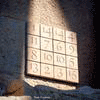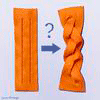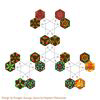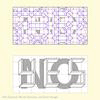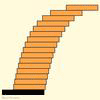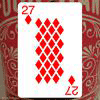Mathematics Awareness Month 2014: Mathematics, Magic, and Mystery
Navigate the Calendar
Over-thinking the Overhang
How far can you get a tower of blocks to lean without falling? In their book Puzzle-Math (Viking, 1958), Gamow and Stern pose the following question:
Consider a case wherein you have access to all the dominoes that you want. This problem is to pile them one on top of the other to build a column with as much offset as you can. You are free to offset each domino at one end as little or as much as you please, but the final column must be stable enough so as not to topple.
One approach to the problem is to start with a perfect vertical stack of n identical blocks, and slide the top block over as far as possible. When it can go no farther without toppling, slide the second block from the top (together with the top block balanced at its tipping point) as far as possible, and then slide the third block, and so on, like this:
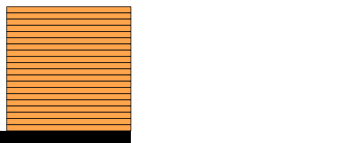
Taking it Further
The beautiful fact is this: If each block is 2 units long, then the top block slides 1 unit, the second block slides 1/2 unit, the third slides 1/3 unit, and so on, until the nth slides 1/n unit. That fact can be derived by keeping careful track of the center of mass as blocks are moved. The total amount of overhang is therefore
And since these blocks have length 2, we multiply this sum by 1/2 to express the overhang in terms of block lengths. This leads to the classic result: A tower of n blocks can be made to overhang
The fundamental question is then: In principle, and with enough blocks, is it possible to achieve any desired overhang? Or is there some natural limit to the amount of overhang, so that any structure that exceeds this limit, no matter how many blocks are used in its construction, cannot stand on its own without collapsing?
In your consideration of this problem, you are free to use dominoes, blocks, playing cards, bricks, or books, and we encourage you to experiment. Any collection of rectangular solids of identical size and weight will suffice.
But what if we allow more flexibility than Gamow and Stern propose? You are free to stack the blocks in any fashion, provided the resulting structure will stand on its own; you need not restrict yourself to blocks stacked in a single column.
With this greater flexibility, the fundamental problem above is easily answered by considering simple structures of this form:

Note: If one of these “diamond” structures has more than 16 blocks, a column of additional blocks must be placed at the top to provide enough weight to hold the structure together. Since we are allowed to use as many blocks as we like, this poses no difficulty for the purpose of demonstrating that arbitrarily large overhangs may be attained (at least in theory).
In the challenge problems below, the goal is to achieve the greatest lean, or overhang, that is possible with a given number of blocks.
- Can you obtain an overhang of exactly one block length using 3 blocks?
- Can you obtain an overhang that exceeds one block length using 3 blocks?
- How many blocks are required to achieve an overhang that exceeds the length of one block?
- Can you achieve an overhang of at least 2 block lengths using no more than 14 blocks?
- To create an overhang of 3 block lengths, which structure uses fewer blocks: A diamond structure with a sufficient column of blocks on top to hold it together, or a tilted stack of the type shown in the orange animation above?
The Underlying Mathematics
Let’s begin with the Gamow and Stern problem from the last section. Start with a perfect vertical stack of blocks, and slide the blocks one at a time from the top down, to create maximal overhang. It is well known that the total overhang in a stack of n blocks, measured in block lengths, is 1/2 times the nth harmonic number
In his article “A dozen harmonious questions,” (Math Horizons, April 2010) James Tanton provides a simple explanation for this fact. The relevant excerpt is available here.
To see that the overhang may be made as large as we like (in theory, and with enough blocks), we show that if n is sufficiently large the above sum can be made to exceed any given number. This is achieved by comparing the sum above with something smaller:
Each grouped collection in the sum above is equal to 1/2. Since we may have as many terms as we like, we may have as many groups as we like, and so the sum may be made as large as we like. A term-by-term comparison shows that the harmonic number is larger than this sum, so it too can be made as large as we like by including sufficiently many terms.
The diamond-shaped structures shown in the previous section demonstrate another way of understanding that overhangs may be made as large as we like. While quite fun to build, those structures use more blocks than are necessary to attain their respective overhangs. In a series of two articles titled “Overhang” and “Maximal overhang” from 2009, Mike Paterson, Uri Zwick, et. al. establish a remarkable fact: A stack with n blocks can attain an overhang on the order of n1/3, and this is the best possible. A brief summary can be found at Ivars Peterson’s Mathematical Tourist blog. For example, below we see the classic harmonic stack with 30 blocks (in orange), and an optimal stack of thirty blocks that achieves the maximal overhang. The blue blocks comprise the counterweight for what the authors call the support set, shown in olive gray.
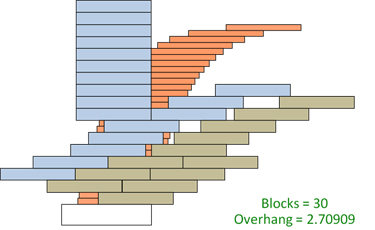
Various versions of the overhang problem have been presented over the years, with the first documented cases occurring in engineering textbooks in the mid-nineteenth century. The problem quoted in the previous section from Gamow and Stern’s Puzzle-Math popularized the problem, but it was Martin Gardner’s Scientific American column (Nov. 1964) that really brought it into the mainstream. All of these presentations focused on the “harmonic stack” shown in orange above.
Interactive demonstrations of the harmonic stack can be found on the Wolfram Demonstrations Project here and here.



